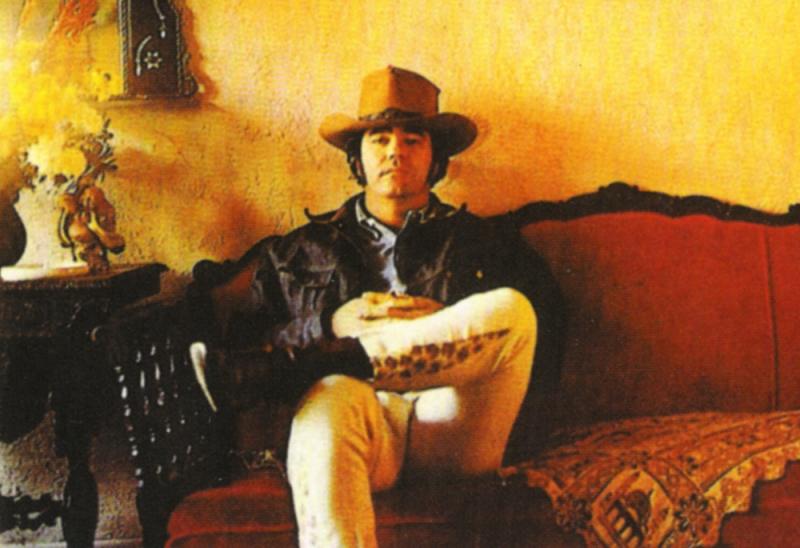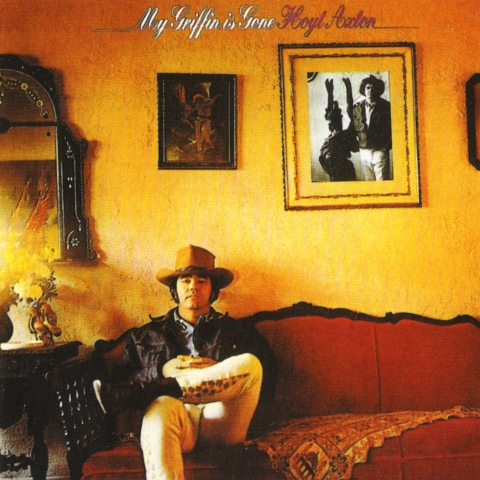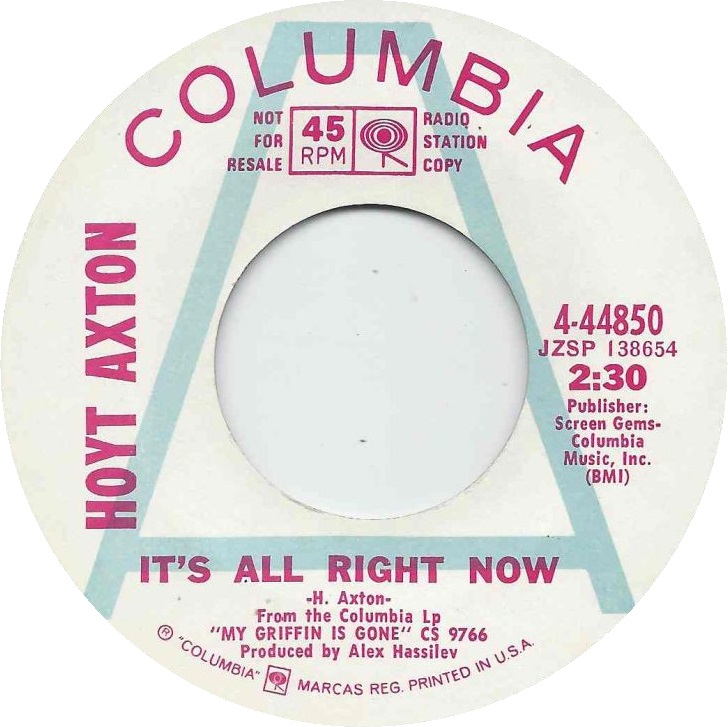Reissue CDs Weekly: Hoyt Axton | reviews, news & interviews
Reissue CDs Weekly: Hoyt Axton
Reissue CDs Weekly: Hoyt Axton
The baroque country masterpiece ‘My Griffin is Gone’ resurfaces

Hoyt Axton’s songs were heard most widely when recorded by others. Steppenwolf recorded his “The Pusher” in 1967. It featured on their early 1968 debut album but was most pervasive in summer 1969 after it was included on the soundtrack of Easy Rider. Axton himself didn’t release a version until 1971, when “The Pusher” appeared on his Joy to the World album. The title track, another of his best-known compositions, had charted earlier that year for Three Dog Night.
While his songs could have commercial appeal, Axton (1938–1999) the recording artist didn’t set the charts alight. Following a few singles, his first album hit shops in 1962. Up to 1984, he regularly issued one each year or so, sometimes two a year. His mother, Mae Axton, was a prolific songwriter and had co-written “Heartbreak Hotel”. His father was a US Navy officer and, after high school, Hoyt Axton spent time in the service. But music became his life.
 Although nominally country, Axton is tough to pigeonhole. He first came to attention during the early Sixties American folk boom, was soon writing his own songs and also tackled blues. In 1963, he covered the stylistically dissimilar Rod McKuen and Willie Nelson. Two years later, he dedicated a whole album to the songs of Bessie Smith. But it is the entirely self-penned album which followed Hoyt Axton Sings Bessie Smith which finally showcased a unique artistic vision.
Although nominally country, Axton is tough to pigeonhole. He first came to attention during the early Sixties American folk boom, was soon writing his own songs and also tackled blues. In 1963, he covered the stylistically dissimilar Rod McKuen and Willie Nelson. Two years later, he dedicated a whole album to the songs of Bessie Smith. But it is the entirely self-penned album which followed Hoyt Axton Sings Bessie Smith which finally showcased a unique artistic vision.
Originally issued in March 1969, My Griffin is Gone is a wonderful response to the psychedelic era rather than psychedelia as such. Its reissue brings the opportunity to celebrate and dig into what makes it special. Its recasting of country is as bold and important as that undertaken by Gene Clark, Gram Parsons and the Bob Dylan of Nashville Skyline. However, Axton did not seek to bring country to a new, non-country audience but instead reframe in entirely. Baroque country may not exist as a genre, but this is what My Griffin is Gone is. If Van Dyke Parks sought to fashion a country album while Curt Boettcher whispered in his ear, this would have been the result.
Reviewing the album a month after the release of trailer single “It’s All Right Now”, the US music biz trade mag Billboard identified “a top programme of unique and compelling folk material from the pen of composer-performer Hoyt Axton.” Songs were singled out for praise: “Beelzebub’s Laughter” was “thought provoking; “Sunrise” offered “much commercial potential” and “Revelations” was “brilliant”.
My Griffin is Gone was his only album for Columbia. Picking him up was prescient. The Easy Rider soundtrack album was on sale in August 1969. My Griffin is Gone was released five months earlier. Like “The Pusher”, every song on the album was about the world as Axton saw it: one in which drugs were having an impact. The ambivalent lyrics have no explicit pro- and anti-drugs stance. In reportage-type verses, Axton describes the effects of drugs. “Snow Blind Friend” (subsequently covered by Steppenwolf) paints a picture of someone “lyin’ on the sidewalk with a misery on his brain, stoned on some new potion.” The dark “Kingswood Manor” tells of a protagonist “floating through the air on a cotton candy cloud” who ends up in a straightjacket locked in a “paisley rubber room” in the titular institution. This was not the drug-inspired reverie of “Lucy in the Sky With Diamonds”.
 On the opening cut, “On the Natural”, Axton sings of going to Colorado, where “up on the mountain, you don’t need your little blue pills.” He is “tired of the plastic people”. On “Beelzebub’s Laughter”, he asks of the war in Vietnam “won’t someone admit it’s a sin?” Retreats from the urban and observations on drug-fuelled shortcuts to revelations are recurring themes. Though listening makes his messages clear, this new, slightly flat-sounding (it lacks the punch of a first-press album), no-frills reissue does not reproduce the original album’s lyric sheet. Also missing from the package is a reproduction of the back of sleeve, where Axton explained the thinking behind the album. “Someone once told me in a dream that truth was a great white bird,” he said. “Here are some feathers I found.” It is vexing that features essential to the album have been disregarded.
On the opening cut, “On the Natural”, Axton sings of going to Colorado, where “up on the mountain, you don’t need your little blue pills.” He is “tired of the plastic people”. On “Beelzebub’s Laughter”, he asks of the war in Vietnam “won’t someone admit it’s a sin?” Retreats from the urban and observations on drug-fuelled shortcuts to revelations are recurring themes. Though listening makes his messages clear, this new, slightly flat-sounding (it lacks the punch of a first-press album), no-frills reissue does not reproduce the original album’s lyric sheet. Also missing from the package is a reproduction of the back of sleeve, where Axton explained the thinking behind the album. “Someone once told me in a dream that truth was a great white bird,” he said. “Here are some feathers I found.” It is vexing that features essential to the album have been disregarded.
Axton’s gravelly, mid-range voice is rich, melodic and conversational – there is a touch of Lee Hazlewood. Each LA-recorded song has a sinuous, complex structure and a memorable melody. His accompanying musicians at the 1968 sessions included the high-end players James Burton (then also playing with Elvis), David Cohen (from County Joe & The Fish), Jim Gordon and Larry Knechtel. Dobro, harmonica and a rhythmic swing ensure the recognisably country is embedded. There is also subtle orchestration. Overall, the similarly significant My Griffin is Gone prefigures Gene Clark’s momentous 1971 album White Light.
My Griffin is Gone was a bold and powerful artistic statement. Billboard said the album was “a winner”. Unfortunately, in commercial terms, it was not. Hoyt Axton never attempted anything this ambitious again.
- Next week: The Doors
- Read more reissue reviews on theartsdesk
Share this article
The future of Arts Journalism
You can stop theartsdesk.com closing!
We urgently need financing to survive. Our fundraising drive has thus far raised £49,000 but we need to reach £100,000 or we will be forced to close. Please contribute here: https://gofund.me/c3f6033d
And if you can forward this information to anyone who might assist, we’d be grateful.

Subscribe to theartsdesk.com
Thank you for continuing to read our work on theartsdesk.com. For unlimited access to every article in its entirety, including our archive of more than 15,000 pieces, we're asking for £5 per month or £40 per year. We feel it's a very good deal, and hope you do too.
To take a subscription now simply click here.
And if you're looking for that extra gift for a friend or family member, why not treat them to a theartsdesk.com gift subscription?
more New music
 Trio da Kali, Milton Court review - Mali masters make the ancient new
Three supreme musicians from Bamako in transcendent mood
Trio da Kali, Milton Court review - Mali masters make the ancient new
Three supreme musicians from Bamako in transcendent mood
 Pop Will Eat Itself's 'Delete Everything' is noisy but patchy
Despite unlovely production, the Eighties/Nineties unit retain rowdy ebullience
Pop Will Eat Itself's 'Delete Everything' is noisy but patchy
Despite unlovely production, the Eighties/Nineties unit retain rowdy ebullience
 Music Reissues Weekly: The Earlies - These Were The Earlies
Lancashire and Texas unite to fashion a 2004 landmark of modern psychedelia
Music Reissues Weekly: The Earlies - These Were The Earlies
Lancashire and Texas unite to fashion a 2004 landmark of modern psychedelia
 Odd times and clunking lines in 'The Life of a Showgirl' for Taylor Swift
A record this weird should be more interesting, surely
Odd times and clunking lines in 'The Life of a Showgirl' for Taylor Swift
A record this weird should be more interesting, surely
 Waylon Jennings' 'Songbird' raises this country great from the grave
The first of a trove of posthumous recordings from the 1970s and early 1980s
Waylon Jennings' 'Songbird' raises this country great from the grave
The first of a trove of posthumous recordings from the 1970s and early 1980s
 Lady Gaga, The Mayhem Ball, O2 review - epic, eye-boggling and full of spirit
One of the year's most anticipated tours lives up to the hype
Lady Gaga, The Mayhem Ball, O2 review - epic, eye-boggling and full of spirit
One of the year's most anticipated tours lives up to the hype
 Slovenian avant-folk outfit Širom’s 'In the Wind of Night, Hard-Fallen Incantations Whisper' opens the door to inner space
Unconventional folk-based music which sounds like nothing else
Slovenian avant-folk outfit Širom’s 'In the Wind of Night, Hard-Fallen Incantations Whisper' opens the door to inner space
Unconventional folk-based music which sounds like nothing else
 'The Art of Loving': Olivia Dean's vulnerable and intimate second album
Neo soul Londoner's new release outgrows her debut
'The Art of Loving': Olivia Dean's vulnerable and intimate second album
Neo soul Londoner's new release outgrows her debut
 Music Reissues Weekly: The Peanut Butter Conspiracy - The Most Up Till Now
Definitive box-set celebration of the Sixties California hippie-pop band
Music Reissues Weekly: The Peanut Butter Conspiracy - The Most Up Till Now
Definitive box-set celebration of the Sixties California hippie-pop band
 Doja Cat's 'Vie' starts well but soon tails off
While it contains a few goodies, much of the US star's latest album lacks oomph
Doja Cat's 'Vie' starts well but soon tails off
While it contains a few goodies, much of the US star's latest album lacks oomph
 Mariah Carey is still 'Here for It All' after an eight-year break
Schmaltz aplenty but also stunning musicianship from the enduring diva
Mariah Carey is still 'Here for It All' after an eight-year break
Schmaltz aplenty but also stunning musicianship from the enduring diva

Add comment